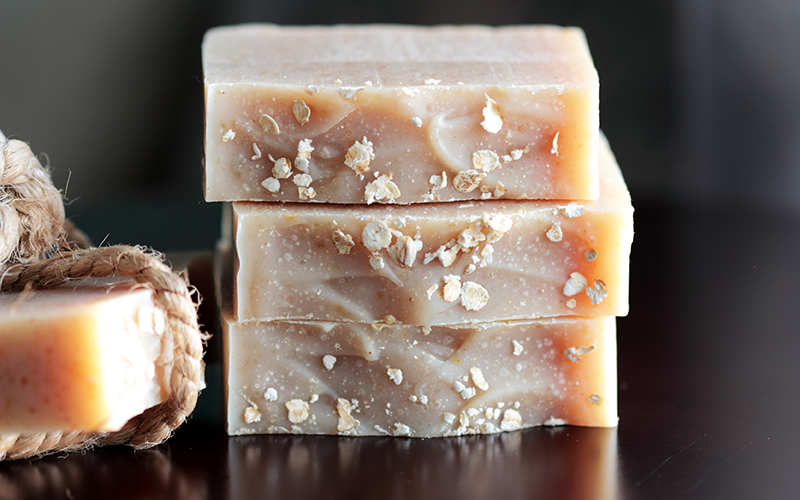Over the years, one small section in my book, Soap and Cosmetic Labeling, has probably generated the most question and online discussion over any other. That section covers “Using an Ingredient in the Name” and discusses the FDA regulations that prohibit the use of the name of one ingredient in the name of the product (if it has two or more ingredients).
What about “Goat Milk Soap” or “Oatmeal Soap” or “Luxe Lotion with Shea Butter?” On the one hand, those product names seem reasonable. But first, let’s take a look at why the regulation might be there in the first place.

A Little History
The Food Drug and Cosmetic Act was signed by President Roosevelt on June 25, 1938. It was the result of a long process to update the earlier law, passed in 1906. There were a lot of factors that went into the creation of the 1938 bill, including broad publication of hundreds of deaths resulting from unsafe products, loopholes in the earlier law, and massive changes in the way food, drugs, and cosmetics were being developed and marketed.
“Fruit Jam” consisting of water, sugar, grass seeds and red dye probably didn’t cause any deaths, but it was just one more example of many false claims and deceptive marketing. That example (and many others like it) may be what ultimately developed into the clause we now have in cosmetic regulation:
Directly from the regulations:
The labeling of a cosmetic which contains two or more ingredients may be misleading by reason (among other reasons) of the designation of such cosmetic in such labeling by a name which includes or suggests the name of one or more but not all such ingredients, even though the names of all such ingredients are stated elsewhere in the labeling.
21CFR:701.1(b)
Intentional Deception
Not too long ago a friend of mine showed me a pump bottle of “Shea Butter,” her new favorite cosmetic product. Since you can’t pump shea butter (it’s very solid at room temperature), I was intrigued. Reading the label, I saw that it was actually “Shea Butter LOTION” and the ingredient declaration showed that there was probably only 1 – 2% shea butter in the product.
Clearly the product was misbranded and in violation of the regulations. Whoever packaged and sold that product was probably trying to deceive—and it worked! My friend knew about the benefits of shea butter and willingly shelled out $25 for a bottle of “Shea Butter” lotion because she expected to get shea butter. Did she get any shea butter? Well, a tiny bit, but probably not the quantity she was expecting for the price she paid.
What’s Included in the “Product Name?”
Obviously, the main statement of the brand or name of the product is the product name. “Luxe Lotion” or “Sally’s Super Soap” or “MyBrand Cream” are all product names.
But what about “MyBrand Gardener’s Helper Cream with Shea Butter“? Well, I checked with the FDA to determine what they consider is part of the product name. Their response: “It depends on what the consumer considers is part of the product name.” In other words, in the example, if “with Shea Butter” is placed in such a way that if looks or feels like part of the name, it probably IS part of the name. On the other hand, if “with Shea Butter” is placed away from the main product name and in a size, color and/or font that clearly distinguishes it as separate from the name, then the consumer would likely consider it “additional information”—not part of the name itself.
Look at the two possibilities below. The one on the left clearly promotes “with Shea Butter” and it is in the same font and color as the name. I read the name of the product to be “Gardener’s Helper with Shea Butter”.
Compared to the label on the right, where I read the product name to be “Gardener’s Helper” and then there is additional information (not part of the name) is that it is a “deep moisturizing cream” “with Shea Butter!”


The Final Take-Away
- Don’t include the name of an ingredient in the product name.
- If you promote one ingredient in the product, do it in a way that makes it a statement separate from the product name.
There is nothing wrong with including marketing information on your product label! There is nothing wrong with promoting that your product includes cool and trendy ingredients! Just use common sense and make sure that your consumer—like my friend with the “Shea Butter Lotion”—doesn’t misinterpret what you are saying about your product.

Shameless plug!
To really be able to create your own labels that comply with the regulations, get my book from Amazon and use it.
4th Edition – Released March 5, 2025!!!
Or order directly from me (and get a signed copy)!


Leave a Reply